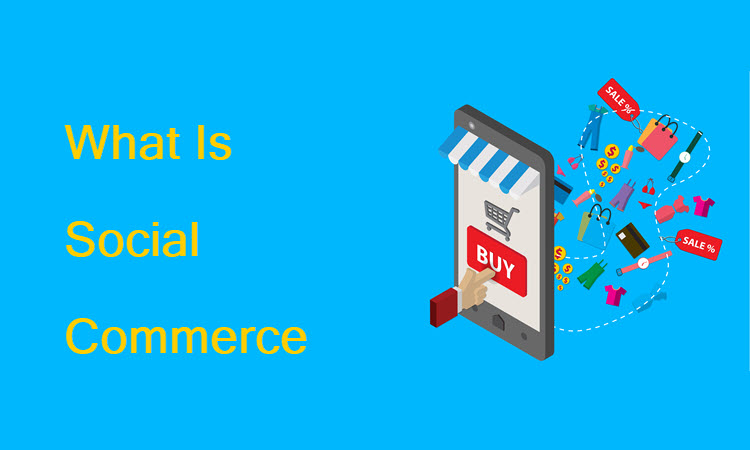As more customers turn to online shopping, the pressure is on merchants to introduce new strategies and solutions to attract a larger audience. This involves meeting potential customers where they spend most of their free time – on social media.
Social commerce takes ecommerce to the next level by using social media not only to promote products and learn about their customers but also to sell. The social commerce experience means customers make purchases directly in the social media app without leaving the environment so that once they have finished shopping, they can return to scrolling, chatting, or sharing.
In this article, learn about the benefits of social commerce and explore strategies that will help you build a successful social commerce plan for your ecommerce business.
What Is Social Commerce?
Social commerce is buying and selling products and services through social media. It involves simplifying the shopping process so that everything from browsing through products to customer service, checkout, and delivery information all take place in one app.
It removes the need to leave the social media platform and go to the merchant’s website to complete the purchase. Businesses love social commerce because it offers increased return on investment (ROI) and encourages repeat purchases.
Social Commerce vs. Ecommerce
The term ecommerce refers to any act of buying or selling items and services online. The purchase may occur via any online sales channel. On the other hand, social commerce is a subset of ecommerce as it focuses on buying and selling goods and services via social media networks.
Note: Another subset of ecommerce is m-commerce. See how these two differ in our article M-commerce vs Ecommerce.
Essentially, both social commerce and ecommerce focus on buying and selling goods and services online, but their approach is different:
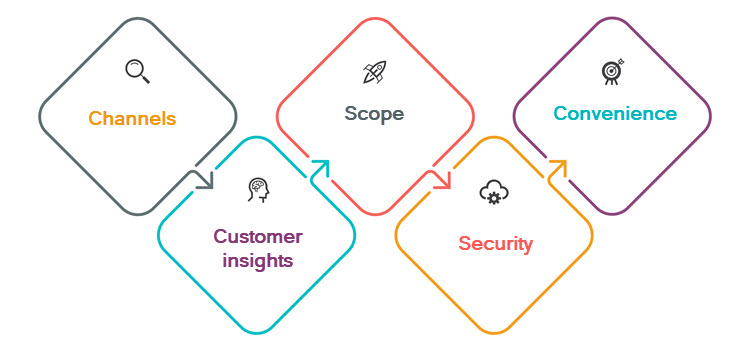
- Channels. Social commerce stays within the environment of the social media app. On the other hand, ecommerce utilizes separate communication channels outside of social media, such as email marketing and ecommerce websites.
- Customer insights. In social commerce, businesses get insight into their customers’ shopping habits and interests through comments, shares, user-generated content, social media analytics and via chat. Essentially, you get a focus group that willingly shares their thoughts on your products and brand. On the other hand, people are less ready to leave their testimonials on ecommerce websites.
- Scope. Often ecommerce businesses promote their best-selling products through social commerce. After they have got the customers’ attention, they will invite them to browse other products on their website. With ecommerce, the entire product range is available in one place with detailed product descriptions, images, and prices.
- Security and reliability. Customers still hesitate to leave their credit card information on Instagram or Facebook. Ecommerce has a better reputation when it comes to providing security because websites require additional authentication.
- Convenience. Ecommerce businesses that implement the entire shopping process in their social media pages are significantly increasing ecommerce sales, since customers can finalize their purchases in one place without leaving the app, thus reducing the chances for abandoned carts.
Note: There are many reasons your customers do not finalize their purchases. To prevent this, read more in our article 13 Reasons for Cart Abandonment Explained.
Social Commerce Statistics and Trends
Here are some notable social commerce statistics to keep in mind:
- Social commerce is taking over the retail and online business world and is expected to reach $3 trillion in earnings by 2026.
- Over half of social media users between the ages of 18 and 24 are shopping through social channels.
- Facebook is the most popular network for social commerce, with 1 out of 5 digital shoppers in the U.S. naming it as their favorite social commerce platform.
- The same research shows that YouTube is considered to be the most trustworthy platform for social commerce in the U.S., with over 60% of shoppers turning to it for shopping recommendations.
- Social commerce is popular for holiday shopping, with over 70% of U.S. shoppers using it for holiday gift purchases.
Benefits of Social Commerce

Here is the list of benefits of implementing a social commerce strategy into your ecommerce business:
- Authentic engagement and brand awareness. Each time a customer posts about your product and tags your business in their feed, they help your engagement grow organically. Both first-time buyers and repeat customers can significantly expand your reach this way and introduce a brand to a bigger audience.
- Frictionless shopping experience. When shopping through social commerce, customers can complete the entire checkout process in one place. The fewer steps customers need to finalize a purchase, the less likely they are to change their minds.
- Enhanced digital presence. Social media combines customer feedback and recommendations with likes, shares, and comments in posts about your brand. This organically increases your company’s digital footprint, bringing more traffic to your ecommerce business.
- Detailed analytics. Social media platforms provide easily measurable ROI metrics, helping analyze business growth and the success of a social strategy. These metrics include impressions, engagement, and reach, as well as the number of followers, likes, and shares on your posts that may result in a purchase.
- Effective product testing. When testing the likeability of a product, social media allows you to simply send out a teaser. The response you get will provide valuable insight into the attractiveness of the product and give you further ideas on how to improve your existing product offering.
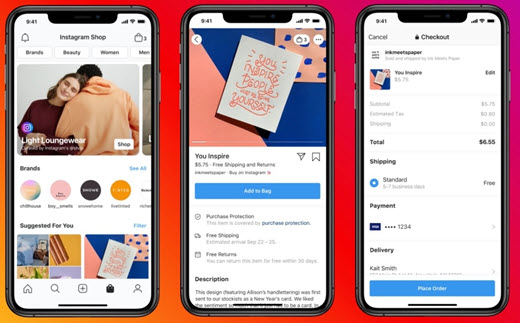
Social Commerce Strategies
Social commerce is a great additional channel for any ecommerce business. Whether you are looking to open up an additional sales channel or want to focus on social commerce exclusively, these social commerce strategies will help you get started.
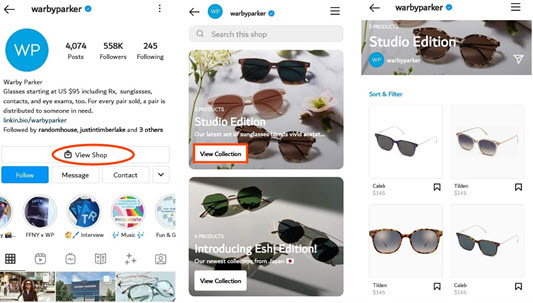
1. Optimize Your Content
Customers turn to social media for education, inspiration, or entertainment, and they want to see high-quality pictures, stories, videos, and reels. Optimizing content with the right keywords and hashtags to deliver a consistent message and relevant information is essential to being noticed. Grow engagement and customer loyalty by continuously optimizing social media content.
2. Provide Quality Customer Support
By using both customer support agents and chatbots in social commerce, you provide all-around support for customers. They can reach out to customer service via chat options to resolve issues, get shopping recommendations, make returns, or give feedback. Facebook and Instagram even allow sellers to add their chatbot to an ecommerce website, helping to integrate social media channels and the online shop.
3. Leverage User-Generated Content
Satisfied customers are the best and most trustworthy advertisers of your product. By encouraging them to leave reviews or share pictures of themselves using your products and tagging your business, you can elevate your social presence and reach a wider audience. Potential customers would rather see ordinary people wearing or using products than big celebrities they cannot relate to.
4. Encourage Action with Shoppable Content
Each product you promote on social media should contain a link that takes the customer directly to the social media storefront. By providing appealing visuals and allowing customers to “shop the look”, you significantly increase engagement and boost sales.
5. Implement Seamless Social Checkout
Facebook, Instagram, Pinterest, and TikTok have in-app checkout options, meaning customers can enter payment details and shipping information without leaving the app. These options are still only available to merchants in certain countries, but the feature is likely to spread globally and to other social media platforms because it removes friction and increases conversion rates.
Note: You can also integrate your social media account with a payment processor to provide in-app payment processing. Learn what a payment processor is and how payment processing works.
6. Personalize the Customer Experience
When researching the potential target audience for a product, focus on their shopping (and scrolling) habits and interests. By understanding which social media platforms they use the most and the type of content they like to consume, you can attract them with your posts and stand out from the competition much easier. Also, you can tailor specific shopping recommendations to draw their attention and create special promotions and discounts to encourage them to finalize a purchase or make a new one.
Note: Personalization is key to attracting and retaining customers. Explore the topic in our article Ecommerce Personalization: All You Need to Know.
7. Promote Cheaper Products First
Customers feel more comfortable shopping for cheaper products via social channels, so start small when building your social commerce strategy. Promote low-cost products first until you build the customers’ trust and confidence to shop more.
Social Commerce Examples
Here are some examples of how ecommerce businesses utilize social commerce strategies on different platforms to reach a bigger audience and boost sales:
Rhode Skin on Instagram
Instagram combines different content forms to provide users with the ultimate scrolling experience, from images to reels and stories. A good example of a brand highly focused on the social commerce aspect of the business is Rhode Skin.
The beauty company created a storefront which allows users to scroll through products and check their descriptions, prices, and availability. Rhode also provides information on shipping, returns, and its cancelation policies. Each product image contains a button that leads customers to the Rhode Skin website, where they can complete the purchase.
Instagram also offers the Get Paid in Chat option for business accounts, where merchants can write up a payment request for a customer to pay with payment cards or PayPal.

Note: Instagram is a powerful tool for increasing your business sales and success. Learn more about how to do it in our article 14 Instagram Ecommerce Strategies to Boost Sales.
Rothy’s on Facebook
Brands focused on their Facebook strategy, such as Rothy’s, aim to offer a more personalized experience for customers outside of their websites. The shop is divided into product groups for easier navigation and clicking on each product image lets customers choose their size and color while also listing the returns and shipping policy.
Customers can browse and save products they like to create a curated list and reach out to customer support on Messenger and WhatsApp to get assistance. As for handling payments, the Facebook Pay option on Messenger enables PayPal, debit, and credit card payments.
Note: Learn the essential difference between the omnichannel and multichannel strategy in our article Omnichannel vs. Multichannel: What Are the Differences?

Snug on Pinterest
Pinterest is one of the social media platforms people go to for home décor inspiration. The London-based sofa company Snug leverages the platform to reach several million potential customers. The company product offering is divided into sections such as “Sofas for Small Spaces” or “Pet-friendly Sofas” and shows the products in a real-life setting, making it easier for customers to decide on a model.
By clicking on the Visit button on the pin, the customer is led to the product page on the website to finalize the purchase. Alternatively, some merchants in the U.S. offer the option to finalize the payment via the Pinterest in-app checkout by simply clicking the Buy button.
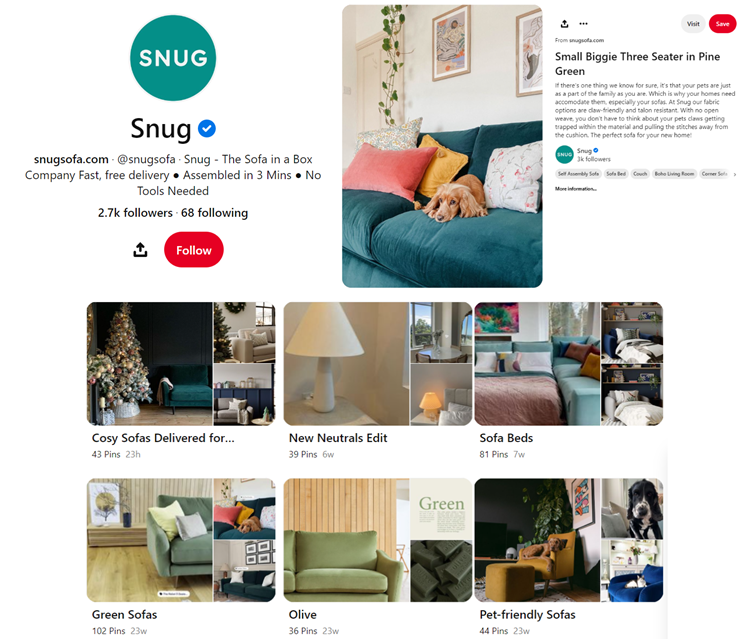
Milk Bar on TikTok
TikTok is one of the fastest-growing social media platforms and is more than just a place for individuals to show off their talents. Brands can take their ecommerce business to the next level by reaching an ever-expanding audience.
Business accounts on TikTok allow customers to shop directly in the app without having to go to the merchant’s website. If the merchant has enabled the “TikTok Shopping” option, customers will see the shopping tab for finalizing purchases on the platform.
The New York-based bakery Milk Bar started sharing daily videos of recipes, ingredients, and new flavors of cakes, pies, and ice cream with followers during the lockdown. This significantly boosted the brand’s reach. Each post leads to the Milk Bar website, where customers can buy their favorite dessert or click on the recipe to try making it themselves.
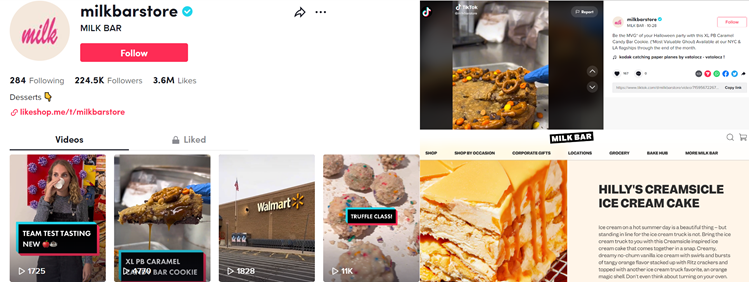
Amazon on Snapchat
Snapchat pioneered the sharing of short videos, the content form that many other social platforms have since added. Thanks to the Snapchat scanning option, customers can snap a picture of any product on their phone and search for it on the app.
The B2C ecommerce giant Amazon regularly includes exclusive promotional codes in its Snapchat videos. Their followers can scan them to get special deals and discounts when purchasing products within a specific time frame, for example during the holidays, on Black Friday, or back-to-school sales.
Amazon expanded its omnichannel presence by connecting with potential customers on this platform. Snapchat allows Amazon customers to virtually try eyewear frames before buying them via Snap Lenses. After choosing their favorite model, customers are sent directly to the product listing on Amazon where they can get more information and complete the purchase.
Note: Brands use Snapchat primarily for promotional activities, while payments are finalized on merchant websites.
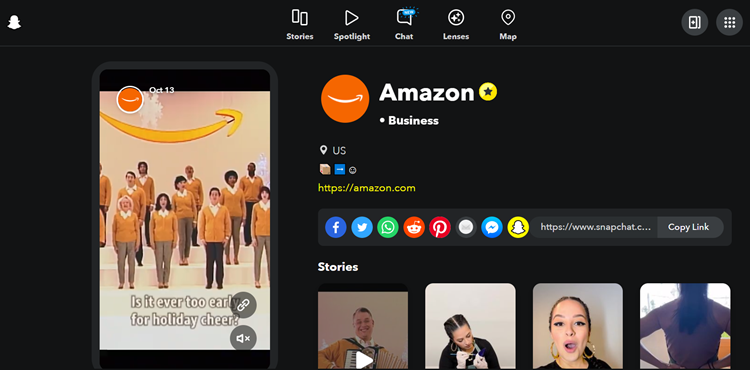
Conclusion
Merchants utilize the ubiquity and influence of social media to reach new audiences and boost sales. By implementing a seamless shopping experience in their social pages, businesses remove the need for customers to switch between the app and the website to finalize a purchase.
With high engagement and optimized conversion rates, social commerce improves the bottom line by communicating with customers directly and in the place where they spend the most time.
